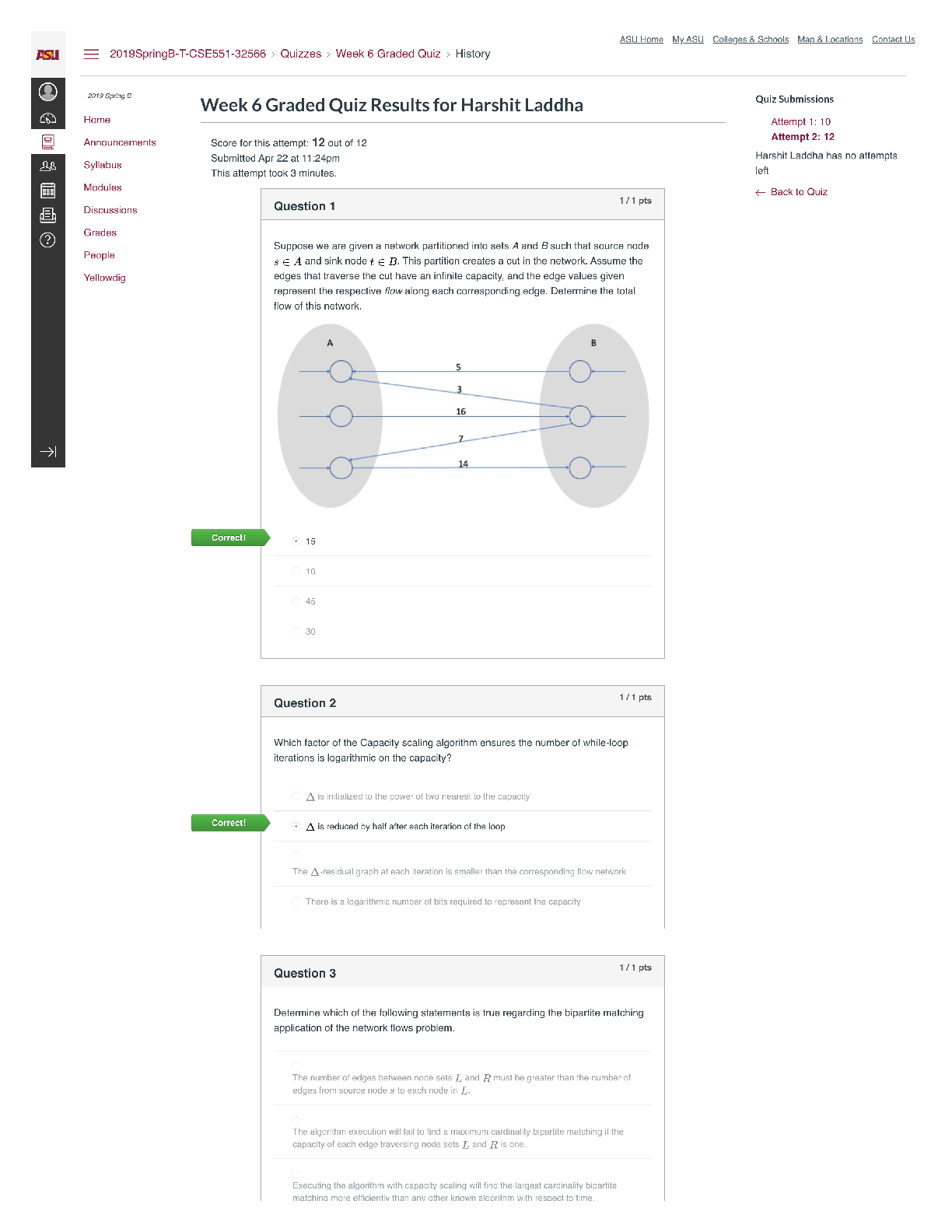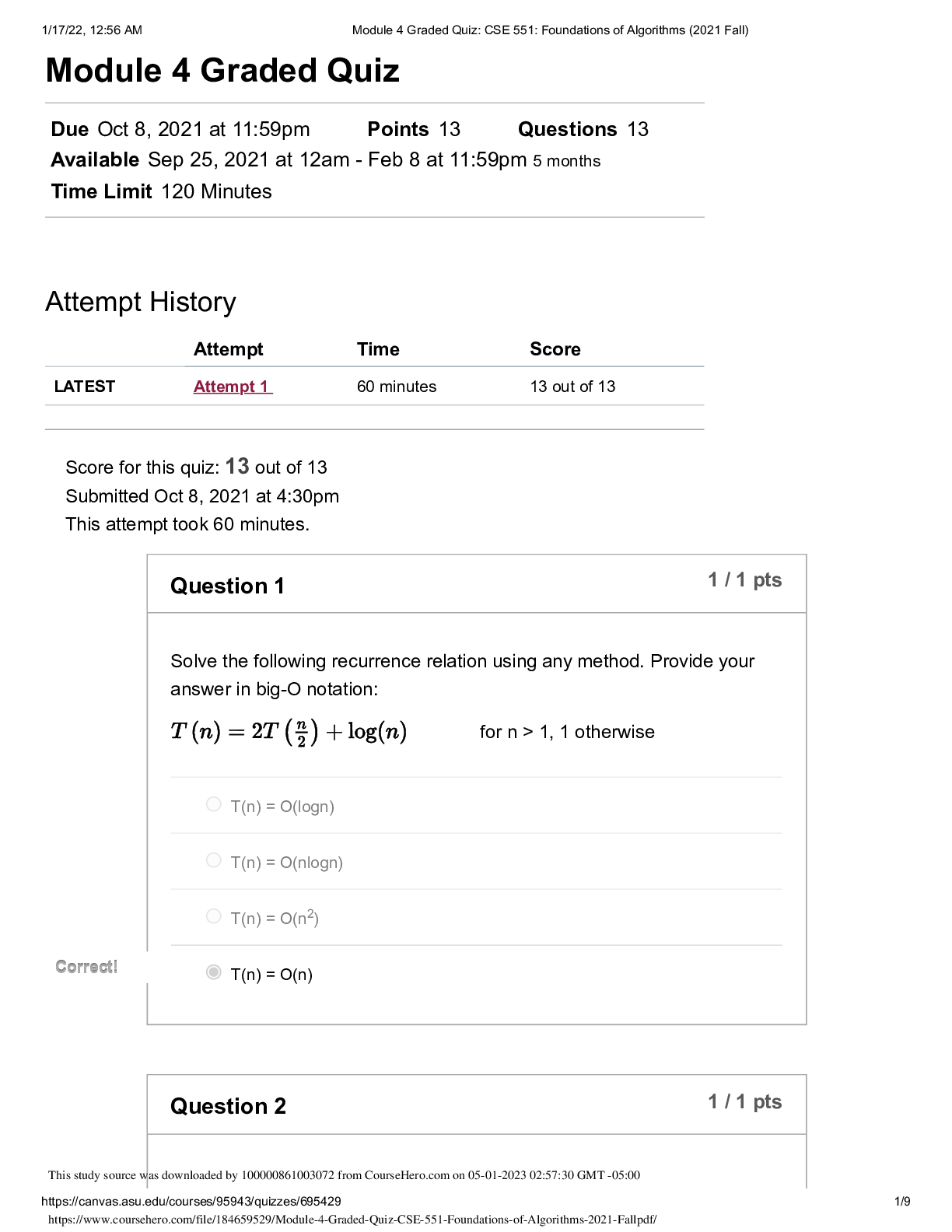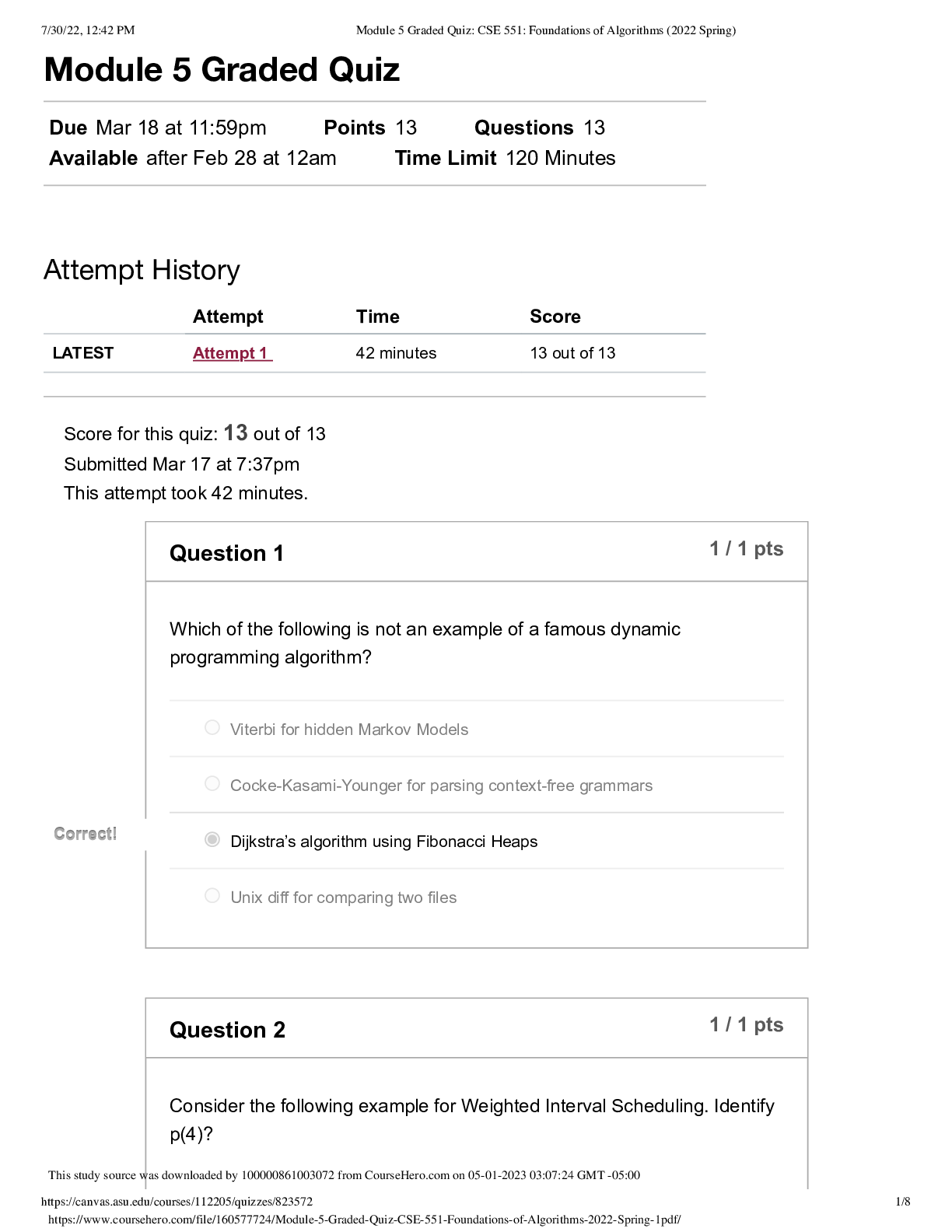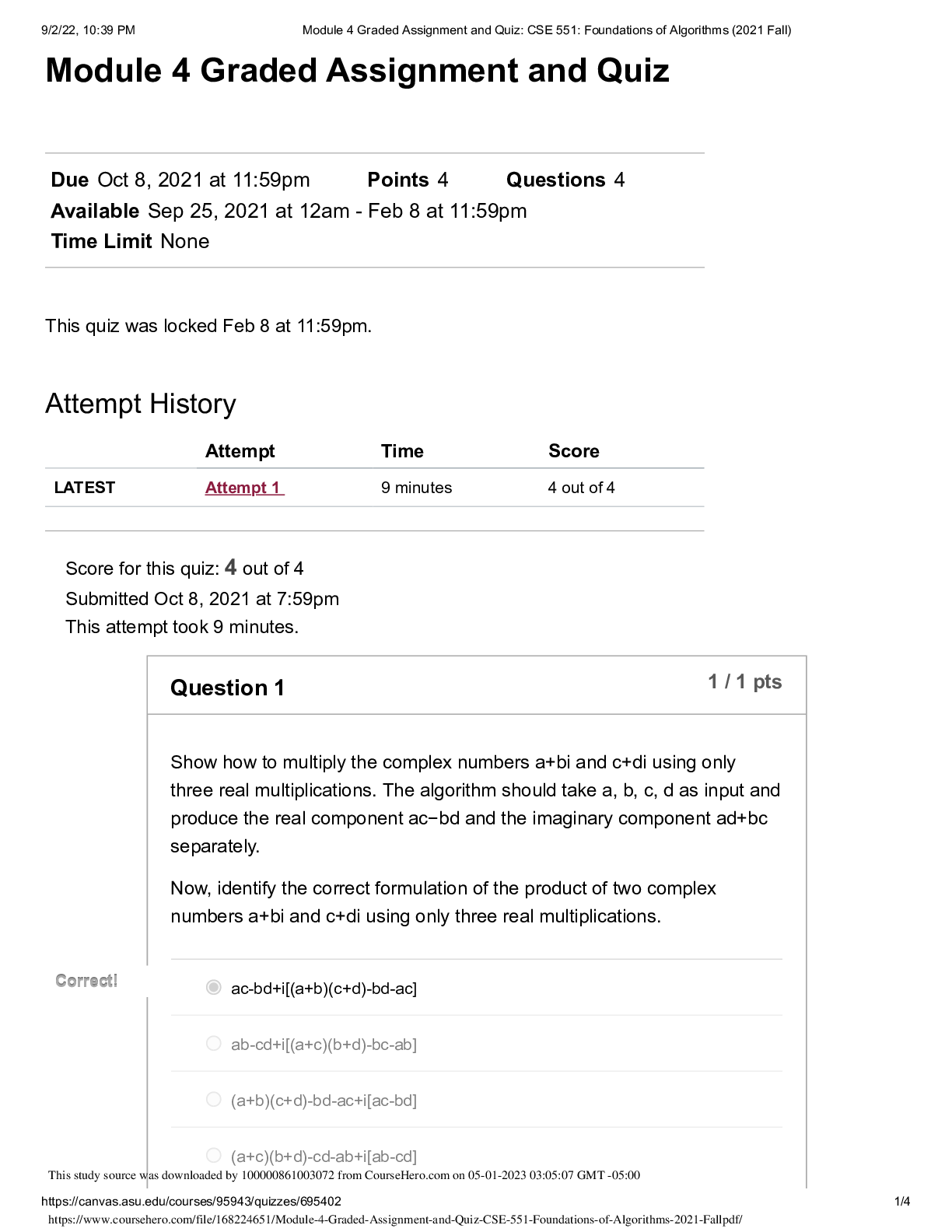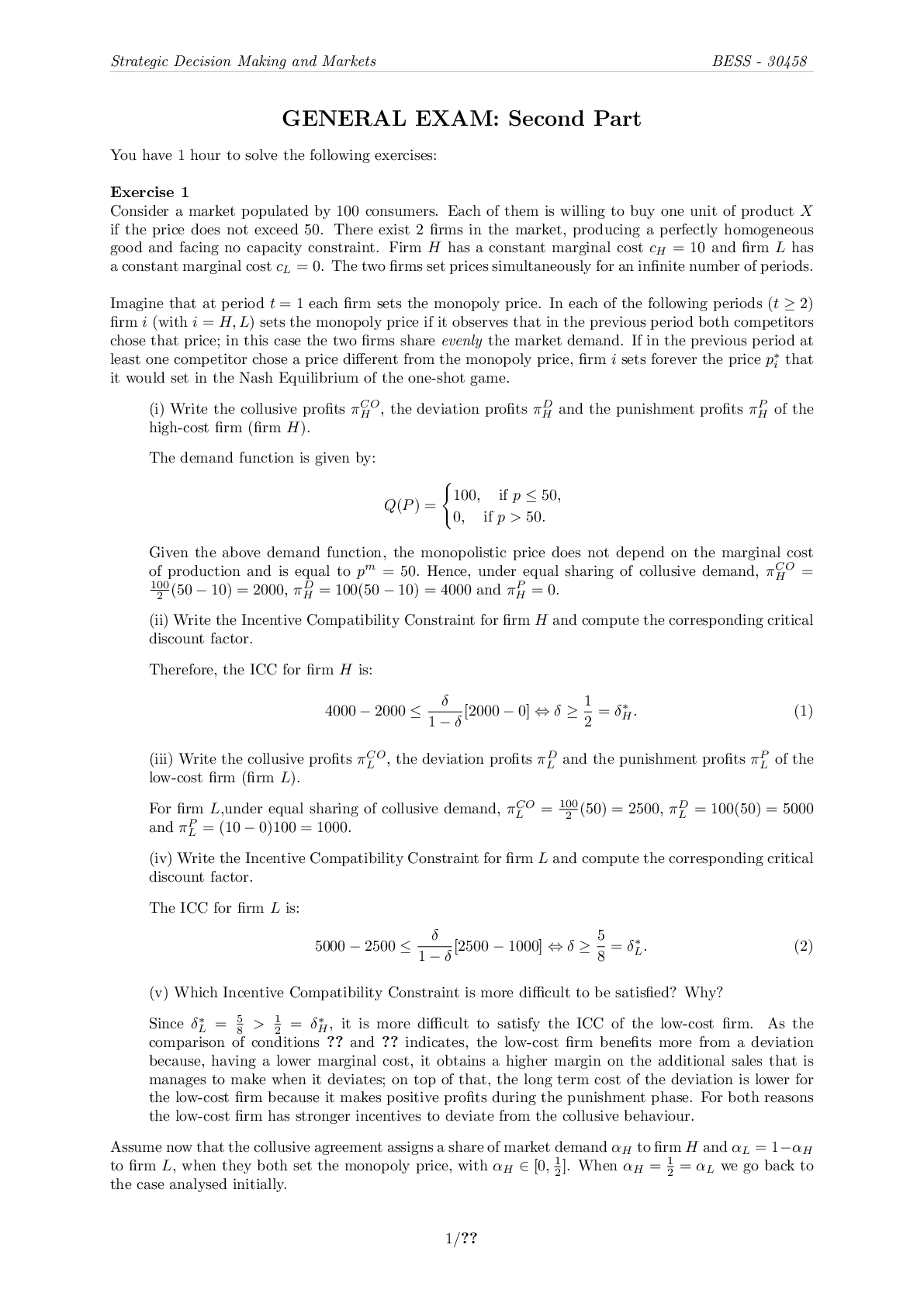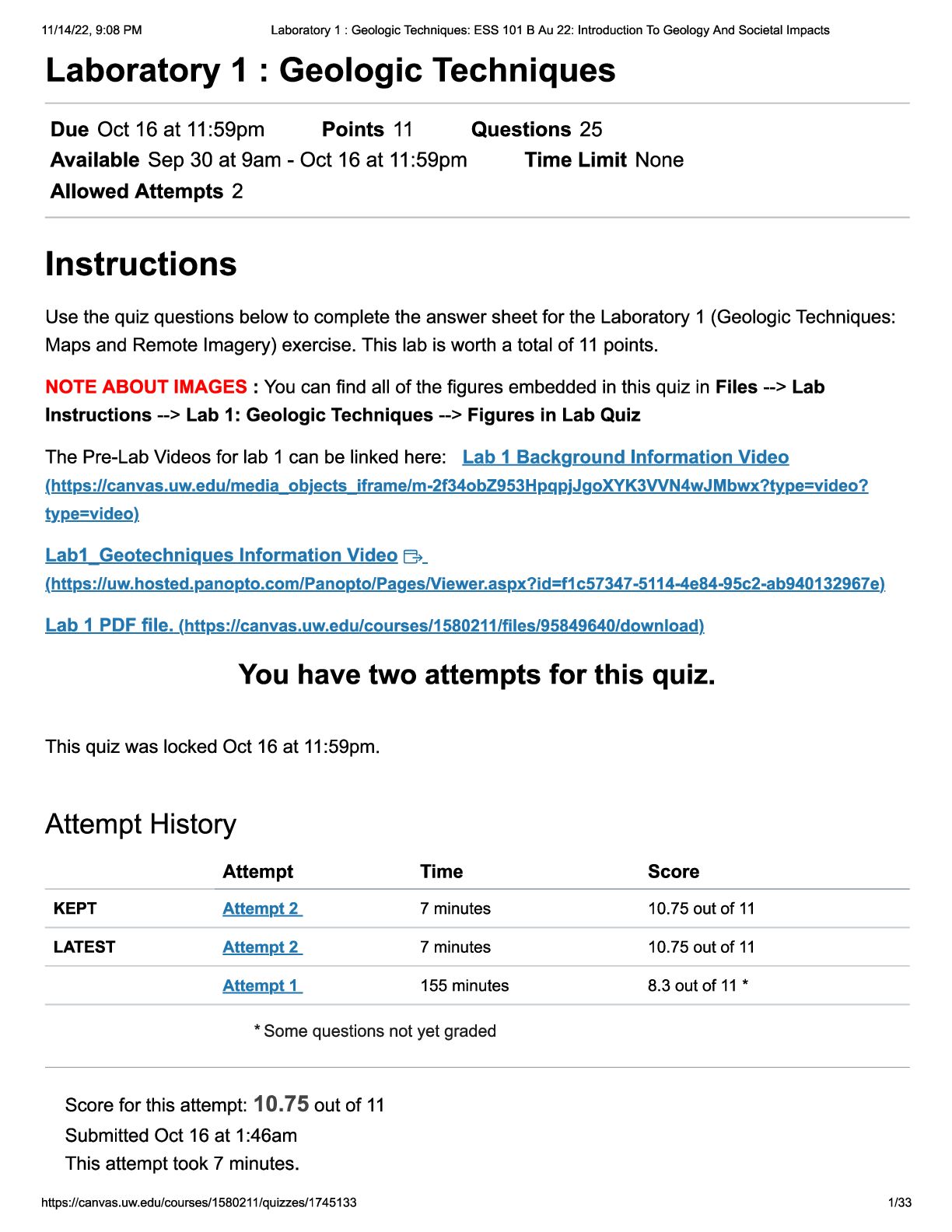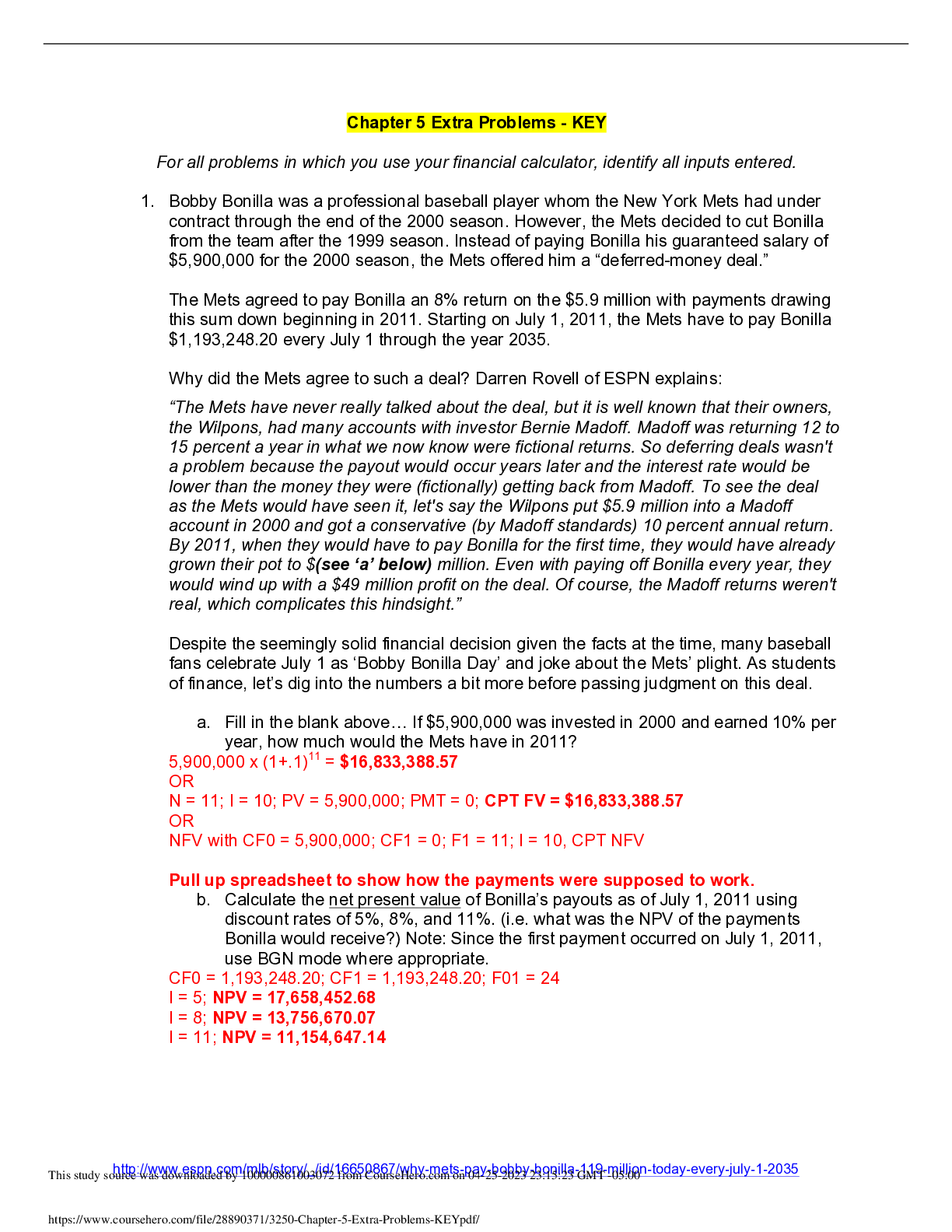Finance > QUESTIONS & ANSWERS > ACCT GENERALLY Completed Exam Wall Street Prep. Review: Accounting Crash Course Retake Exam v4. (Que (All)
ACCT GENERALLY Completed Exam Wall Street Prep. Review: Accounting Crash Course Retake Exam v4. (Questions and Answers, All explained)
Document Content and Description Below
Back to Exams Review: Accounting Crash Course Retake Exam v4 Score: 92%, 24 correct out of 26 | Taken On: 06-19-20 Question 1 Assume US GAAP to answer this question. In 2017, $2 million in wages... were earned and no cash wages were paid. In 2018, $8 million in wages were earned and $9 million in cash wages were paid. Cash wages were used to first pay wages earned in 2017 with the remainder used to pay wages earned in 2018. Any earned but unpaid wages will be paid during the first quarter of 2019. Using only the information provided, which of the following statements is most accurate? Liabilities decreased by $1.0 million in 2018. Liabilities increased by $6.0 million in 2018. Assets decreased by $7.0 million in 2018. Retained earnings decreased by $10.0 million in 2018. Retained earnings decreased by $9.0 million in 2018. . Since wages were earned in 2017 but not yet paid, the opening balance sheet in 2018 would have an accrued wages liability of $2.0. These were paid in 2018, reversing the liability. However, since there is only $7.0 million in cash ($9.0 less the $2.0 million used to pay 2017 wages) available to pay wages earned in 2018, that leaves $1.0 million in earned wages unpaid, lowering the accrued wages liability to $1.0 million. The net impact to the liability is -$1.0 million (-$2.0 + $1 million). The only asset impacted is cash, which decreases by $9.0 million, while retained earnings decreases by $8.0 million, since wages are expensed when they are earned, not when they are paid. See Lesson: Payable, Accrued Expenses, Deferred Revenue & Debt Question 2 A company reported gross profit of $22 million in 2018. In addition, it recorded the following activities: Sales and marketing expenses were $6 million. Interest expense was $1 million. Sold equipment for $13 million that had a net book value of $9 million. $3 million in preferred stock issuance. Company’s tax rate is 40%. Calculate the company’s net income. $9.0 million $9.6 million $11.4 million $12.6 million $15.0 million . Gross profit 22.0 Selling and marketing expenses (6.0) Interest expense (1.0) Gain on sale 4.0 Pretax income 19.0 Tax rate 40% Net income 11.4 Gain on sale is calculated as the sale price less the net book value. See Lessons: Net Income, EPS & Dividends Property, Plant & Equipment, Part 2 Question 3 The next two questions use the following data from TGX Global, a heavy equipment manufacturer (this information will be repeated on the next question): TGX Global sells excavators, with an average sale price of $750,000 per excavator. TGX received new orders for 100 excavators in 2018. TGX produced & delivered 130 excavators in 2018: 70 of these delivered excavators were ordered in 2017 and the rest (60 excavators) were part of the 100 ordered in 2018. TGX received payment for 120 excavators. TGX began selling 1-year maintenance services contracts for $60,000 per excavator in 2018, which begin after the excavator is delivered. Contracts were sold on 50% of all excavator orders made in 2018 (no contracts were sold on orders placed in 2017) Assume all excavators delivered in 2018 are delivered at year end. Calculate TGX’s 2018 revenue based on the transactions described above. $75.0 million $78.0 million $97.5 million $100.5 million $101.4 million . According to the revenue recognition principle, a company cannot record revenue until that order is shipped to a customer (or a service has been provided) and collection from that customer is reasonably assured. 130 excavators were shipped and delivered in 2018 at a price of $750,000 each, which implies $97.5 million of revenue. The maintenance agreement cannot be recognized as revenue until the service is provided, since excavators were delivered at year end, no revenue from the service agreement can be recognized in 2018. See Lesson: Basic Accounting Principles Question 4 This question uses the same TGX Global data as the previous question, repeated below: TGX Global sells excavators, with an average sale price of $750,000 per excavator. TGX received new orders for 100 excavators in 2018. TGX produced & delivered 130 excavators in 2018: 70 of these delivered excavators were ordered in 2017 and the rest (60 excavators) were part of the 100 ordered in 2018. TGX received payment for 120 excavators. TGX began selling 1-year maintenance services contracts for $60,000 per excavator in 2018, which begin after the excavator is delivered. Contracts were sold on 50% of all excavator orders made in 2018 (no contracts were sold on orders placed in 2017). Assume now that instead of the revenue recognized in the previous question, TGX recognized $75 million in revenue for 100 excavators (and assume no maintenance contract revenue was recognized). In addition, the following occurred in 2018: TGX recognized $3 million in shipping and delivery costs for its excavators. TGX recognized $7 million in direct labor expenses. TGX recognized $3 million in commissions paid to its salespeople for selling the excavators. TGX purchased $60 million in raw materials in 2018, of which $50 million was in cash. Raw materials required to assemble each excavator cost $500,000 per excavator. Calculate TGX’s 2018 gross profit based on the transactions described above. $11.0 million $14.0 million $15.0 million $18.0 million $35.0 million . Gross profit is revenue less cost of goods sold. Cost of Goods sold represents a company's direct cost to manufacture or procure goods and services. According to the matching principle, costs associated with the production of the book should be recorded in (matched to) the same period as the revenue from the book’s sale. Revenue from 100 excavators was recognized and the corresponding cost of $500,000 each or $50 million should be matched. In addition, shipping, delivery and direct labor costs are included in the direct production of the excavator and should thus be included in COGS. Sales, marketing and general expenses are not included in COGS. See Lesson: COGS & Gross Profit Question 5 Fairview Corporation recorded the following in 2018: After-tax net income was $25 million in 2018. The actual share count at the beginning of the year was 15.0 million. Fairview repurchased 3 million shares at $12/share in the middle of 2018. Fairview issued preferred dividends of $5 million and common dividends of $5 million. Fairview issued 5 million stock options in 2018, 1 milllion of which vested in the middle of 2018. Calculate 2018 basic earnings per share (EPS). 1.07 1.29 1.43 1.67 1.79 . Net income must be reduced by preferred dividends in the basic EPS calculation. Unvested shares do not get included in the basic share count, only the diluted. The share count is a weighted average. Both shares were repurchased and options vested in the middle of the year , the average is = 14.0 million weighted average shares. Net income 25.0 Preferred dividends (5.0) Net income to common 20.0 Basic Shares - BOP 15.0 Basic Shares - EOP 13.0 Basic Shares - Weighted Average 14.0 Basic EPS 1.43 See Lessons: Net Income, EPS & Dividends Financial Statement Analysis Question 6 Dynamic Resources reported the following information for year ending June 30, 2016 (values in millions): Plant, Property & Equipment, gross $5,000 Accumulated Depreciation 1,500 Plant, Property & Equipment, net 3,500 Salvage Value 300 The company also reported the following transactions on the first day of fiscal 2017: Sale of asset with gross PP&E of $700 million for $500 million and useful life of 7 years and no salvage value. Recorded a gain on sale of $400 million. Write off of asset with gross PP&E of $600 million. Asset was purchased 3 years ago with original useful life of 4 years and salvage value of $300 million. Purchase of new equipment for $1,600 million with useful life of 8 years and no salvage value (purchased on the first day of fiscal 2017). Assuming the remaining useful life of other equipment is 9 years on a straight-line basis, what is the net PP&E as of June 30, 2017 (rounded to nearest thousand)? $4,088.9 million $4,288.9 million $4,355.6 million $4,555.6 million $4,725.0 million . First calculate the PP&E balance on the first day of FY2017. The asset was sold for $500 million and a gain of $400 million was recognized, which implies a net PP&E value of $100 million. The write off is for gross PP&E of $600 million that has been depreciated at $75 million (($600-300)/4) for 3 years, which implies a net PP&E value of $375 million (including the $300 million salvage value). Starting with $3,500 million of net PP&E, subtracting $100 million for the sale and $375 million for the write down leaves $3,025 million of other equipment with no salvage value (due to the write down). $1,600 of new equipment is purchased, which increases net PP&E to $4,625 million. After one year, the other equipment is depreciated by $336.1million reflecting remaining useful life of 9 years and the new equipment is depreciated by $200 million reflecting a useful life of 8 years. Net PP&E for FY2017 is $4,625 – 336.1 – 200 = $4,088.9 million. See Lesson: Depreciation Question 7 Information about the assets of TAP Holdings is provided below: TAP purchased land on January 1, 2013 for $500 million. As of January 1, 2018, the fair value was estimated to be $550 million. TAP purchased a trademark on January 1, 2016 for $300 million. As of January 1, 2018, the fair value was estimated to be $200 million. TAP acquired a company on Jun 5, 2016 and recognized $1100 million in goodwill as a result. A $150 million goodwill impairment was recognized at year end 2017. Assume a useful life of 5 years and the straight-line method for any depreciable or amortizable assets above. Assume TAP reports under US GAAP. What is the total value of these assets reported on TAP’s balance sheet as of January 1, 2018 $1,610 million $1,650 million $1,700 million $1,800 million . GAAP financial statements report companies’ resources at an initial historical cost (unless written down). GAAP requires that firms only show measurable activities, such as the value of acquired intangible assets. The current reported value of the land would be the lower historical cost of $500. The current reported value of the trademark would be written down to the lower fair value of $200. Goodwill would also be reported at the lower fair value of 950. The total value of the assets would be $500 + $200 + $950 = $1,650. Land, trademarks and goodwill are considered are generally considered to have indefinite useful lives and not depreciated or amortized. See Lessons: Basic Accounting Principles Intangible Assets & Goodwill Question 8 For the next 2 questions, use the financials of Acme Corporation. After adjusting revenue for accounts receivable and deferred revenue, how much cash did Acme generate from revenue for the three months ending September 30, 2017? $234.4 million $241.1 million $274.8 million $369.4 million . Accounts receivable increased by $87.7 million, implying that the company did not collect that amount in cash. Deferred revenue increased by $40.4 million, which the company collected but did not book as sales. Therefore, cash collection was $322.1 million - $87.7 million + $40.4 million = $274.8 million. See Lessons: Cash, Receivables & Prepaid Expenses Payable, Accrued Expenses, Deferred Revenue & Debt Question 9 For this question, use the financials of Acme Corporation. Note the industry average ratios below: A/R days (based on average balances) = 57 days A/P days (based on average balances) = 23 days Current ratio (based on ending balance) = 1.8x Based on Acme’s A/R days, A/P days and Current ratios for the three months ending September 30, 2017, which of the following conclusions is most accurate? Assume 92 days in the three months ending September 30, 2017 and 365 days in the year. Compared to the industry average: Acme has more favorable collection terms but less favorable payment terms with vendors. Acme has more favorable collection terms and more favorable payment terms with vendors. Acme has less favorable payment terms with vendors and a less favorable current ratio. Acme has less favorable collection terms and less favorable current ratio. Acme has less favorable collection terms and less favorable payment terms with vendors. . The activity ratios are calculated below: Activity ratios Acme Industry A/R Days = Average A/R / YTD Revenue * 92 76 days 57 days A/P Days = Average A/P / YTD COGS * 92 2 days 23 days Current Ratio = Current Assets / Current Liabilities 2.0x 1.8x Lower A/R days is favorable because if you collect very fast from customers, you immediately get cash. Higher inventory turnover is advantageous because it means you do not need large amounts of cash for inventory requirements until a sale is actually made. Higher A/P days is favorable because a company can take longer to pay vendors and longer credit terms provide more flexibility. The current ratio gauges the ability of a company to cover short term financing needs. A current ratio > 1 is good. It implies that there are more liquid assets than short term liabilities, reflecting a healthier level of liquidity. See Lesson: Financial Statement Analysis Question 10 For the next 3 questions, use the Grove Analytics Financials. Calculate Grove's 2018 cash from operations. 167 170 173 179 . 12/31/2018 Net income 132 Depreciation 35 Stock based compensation 9 Accounts receivable 5 Inventory 1 Accounts payable (3) Cash from operations 179 See Lesson: Cash From Operations Question 11 This question uses the Grove Analytics Financials. Calculate Grove's 2018 cash from investing activities. (65) (30) 30 65 . Capex (65) CFI (65) See Lesson: Cash From Investing Question 12 This question uses the Grove Analytics Financials. Calculate Grove's 2018 cash from financing activities. Calculate 2018 cash from financing activities for Grove Analytics. Hint: Remember to capture dividends. Also, remember that stock based compensation expense is a credit to common stock & APIC. (71) (78) (79) (88) . Cash from debt proceeds 3 Equity proceeds - common stock & APIC rose by 10 but this is not the whole story: 9 of that / 10 increase came from noncash stock based compensation (per the I/S). This implies a total cash equity issuance of 10 – 9 = 1. 1 Share buybacks (5) Dividends (we know this because we knew net income and beginning and end of year retained earnings). The plug must be dividends. (87) CFF (88) See Lesson: Cash From Financing & Cash From Investing Question 13 Barney Corporation reported the following figures for their year ending December 31, 2019: Gross profit: 672,000 Cost of goods sold: 463,000 Net income: 350,000 Using the data above, calculate Barney Corp's 2019 Gross Profit Margin. 0.8% 40.8% 59.2% 68.9% . Gross profit margin = gross profit / revenue. Gross profit = Revenue - COGS. We can back solve for Revenue as Gross profit + Cost of goods sold = $1,135,000. This yields a gross profit margin of $672,000/$1,135,000 = 59.2% See Lesson: COGS & Gross Profit Question 14 Which of the following activities are credits? 1. The impact on accounts receivable from a $20 million sale to a customer. 2. The impact on treasury stock from a company repurchasing $40 million in shares. 3. The impact on inventory from a company recognizing $25 million in cost of goods sold expense. 4. The impact on debt from a $10 million principal paydown. 1 only 2 and 3 3 and 4 3 only . 1 is a debit because A/R goes up from a customer sale. 2 is a debit because treasury stock is declining (equity declining is a credit) and 4 is a debit because debt goes down. 3 is a credit because inventory goes down as COGS is recognized. See Lessons: Double Entry Accounting Cash, Receivables & Prepaid Expenses Inventory Equity Question 15 On January 1, 2019, Fitbit goes public and issues 100 million shares at $20 per share. Fitbit had 200 million shares prior to going public and the book value of the common stock & additional paid in capital was $1,000 million. On January 1, 2020, Fitbit shares are trading at $45 per share and, for the first time ever, Fitbit buys back 20 million shares. What is the January 1, 2020 balance of common stock & APIC? $13.5 billion $11 billion $3.0 billion $2.1 billion . CS & APIC rise during the IPO from $1.0 billion original book value plus the IPO value of by $20 * 100m shares = $3.0 billion. When a company buys back shares, nothing happens to common stock & APIC so the balance stays as is. See Lesson: Equity Question 16 Barney Corporation recognized a $50 million preferred stock balance on 12/31/2019. On January 1, 2020, Barney issued $20 million in preferred dividends. On the same date, Barney raised an additional $30 million via a new issuance of preferred stock. On December 31, 2020, the market value of the original amount of preferred shares rose $10 million. Under US GAAP, the 12/31/2020 year ending preferred stock balance is: $40m $60m $80m $100m . Calculated as $50m + $30m. Preferred stock cannot be written up to market value on the balance sheet and must remain at historical cost. Preferred dividends reduce retained earnings, not the preferred stock balance. This is like the concept that interest expense lowers retained earnings as opposed to the debt balance. See Lesson: Equity Question 17 Squat XFit Inc. reported the following activities during 2020. Activities during the year ($ in millions) 2020 Capital expenditures 72.5 Cost of goods sold 41.1 Cash purchases of inventory 32.9 Dividends 7.0 Income tax rate 25% Interest expense 41.6 Net revenues 168.2 Other operating expenses 17.3 Purchases of intangible assets 39.0 Loss from sale of land (7.0) Selling, general, & administrative 12.6 Write-down of PP&E 3.0 Interest income 2.0 Depreciation expense 15.0 Amortization expense 7.5 Write down of inventory 2.5 Stock based compensation expense 15.0 Paydown of short term debt 5.0 Calculate net income for the year ending 12/31/2020. $5.70 million $9.83 million $10.95 million $11.85 million . Review your answer with the SquatFix Activities Solution File. See all lessons in chapter The Income Statement. Question 18 Squat XFit Inc. reported the following ($ in millions). Financial results 2020 Revenue 122.1 EBITDA 60.9 Interest income 7.0 Tax rate 25.0% Interest rate on debt 5.0% Balances as of 12/31/2019 12/31/2020 Net PP&E 198.8 240.0 Intangible assets 40.0 45.0 Debt 155.0 155.0 Purchases Assume purchases made at year end and thus did not generate D&A in 2020 2020 Capital expenditures 75 Purchases of intangible assets 20 Calculate net income for the year ending 12/31/2020 $8.5million $9.1 million $11.4 million $14.3 million . Review your answer with the SquatFix Financials Solution File. See all lessons in chapter The Income Statement. Question 19 Squat XFit Inc. reported the following activities and select balance sheet items ($ in millions). Select results during year ending December 31, 2020 Revenue 387.6 Interest expense 13.0 Depreciation expense 37.5 Stock based compensation 8.0 Tax rate 40% Net income 108.5 Balances as of: 12/31/2019 12/31/2020 Accounts payable 130.5 108.0 Accounts receivable 75.2 77.6 Common Stock & APIC 145.0 165.0 Deferred revenue 319.0 335.0 Inventory 145.0 151.8 Current portion of debt 195.0 205.0 Long term investments 98.7 110.1 Net PP&E 198.8 227.1 Pre-paid expenses 45.0 50.0 Treasury stock (88.4) (147.0) Accrued wages 69.0 74.5 Other comprehensive income 4.5 9.2 Calculate cash flow from operations for the year ending 12/31/2020: $138.8 million $143.5 million $167.2 million $169.2 million . Review your answer with the SquatFix Activities and Balance Sheet Solution file. See lesson: Cash From Operations Question 20 Kephlee is an amusement park operator and provided the following select financial data: ($ in millions) December 31, 2020 Revenue $98.7 December 31, 2019 December 31, 2020 Accounts receivable 115.1 110.9 Deferred revenue 49.2 46.6 Based on the information provided, what were cash sales during 2020? $97.1 $100.3 $118.8 $120.4 $122.0 . Deferred revenue represents cash sales not yet recognized on the income statement (i.e. the company hasn’t earned the sale yet – like a gift card or a warranty). As this liability decreases year over year, sales must be adjusted when attempting to arrive at cash sales. Conversely, accounts receivable represent sales recognized for which cash has yet to be received. Year over year declines in this asset must be reflected as an upward adjustment from recognized sales to cash sales. Proceeds from fixed asset sales are not sales. Instead the gain on sale is recognized as an operating gain below sales on the I/S. Cash from operations is a distraction. See Lessons: Revenue Recognition Payable, Accrued Expenses, Deferred Revenue & Debt Cash, Receivables & Prepaid Expenses Question 21 Bazman is an electronics retailer and provided the following select financial data (assume income statement items are for the full year): ($ in millions) December 31, 2020 Gross profit $122 Operating expenses 58 Accrued expenses 14 Prepaid wages 21 Depreciation & amortization expense 17 Prepaid rent 6 Stock based compensation expense 5 Other comprehensive income 2 Tax rate 25% Net income 31 Based on the information provided, what was operating income during 2020? $28 $40 $42 $64 . Gross profit is revenue less COGS. From there we need to subtract operating expenses recognized on the income statement in the current period which include operating expenses, D&A, and stock based compensation. Accrued expenses, prepaid wages, and prepaid rent are balance sheet items. Other comprehensive income does not impact the I/S, but rather the Other Comprehensive Income balance sheet item. Tax and net income are distractions. See all lessons in chapter The Income Statement. Question 22 Which of the following would you not see explicitly identified on a cash flow statement prepared using the indirect method? Cash interest expense Depreciation expense Payment of loan principal Repurchase of shares The cash flow statement prepared under the indirect method begins with net income as its starting point and reconciles to cash from operations. Since interest expense is included in net income, it will be embedded in net income and therefore not explicitly identified on the cash flow statement. Depreciation expense is an addback to net income in the cash from operations section, payment of loan principal and repurchase of shares are outflows in the cash from financing section. See Lesson: The Cash Flow Statement Question 23 In Q1 2018, CNA Companies reports the following transactions: Capital expenditures of $32 million Gain on sale of equipment of $10 million Debt borrowing of $10 million Preferred dividend of $4 million Common dividend of $5 million Share buyback of $2 million Ignoring the effect of taxes, what is the impact of these transactions on retained earnings? ($9 million) $1 million $5 million $10 million . Retained earnings represent a company’s cumulative earnings, net of dividends, over its entire existence and is not impacted by financing activities such as debt issuance/paydown or stock issuance/buybacks. Capital expenditures do not directly impact retained earnings. Rather, the resulting depreciation expense, which is not reported, has an impact. The total impact is $1 million, comprised of $10 million from the gain on sale and ($9 million) from preferred and common dividends. See Lesson: Equity Question 24 Blueberry is a consumer technology company that reported the following financials (values in millions): 2017 2018 Revenue $222 $275 Deferred Revenue (ending balance) $115 $100 Which of the following statements about the reason for the decrease in deferred revenue from 2017 to 2018 is most plausible? More revenue was recognized than cash was collected during 2018. More gift cards have been redeemed than sold during 2018. Higher number of prepaid streaming service subscriptions were sold during 2018. A higher number of smartphone extended warranty contracts were sold during 2018. . Deferred revenue represents sales that a company has received payment for but not yet earned and therefore cannot classify as revenues on the income statement. Examples of unearned revenues are magazine subscriptions (a company has not yet delivered those magazines to customers) and gift cards. More gift cards redeemed than sold would result in a decrease in deferred revenue. A higher number of extended warranty contracts would result in higher deferred revenue as cash is collected upfront with a corresponding deferred revenue liability, which is reversed in the future as revenue is recognized over the life of the warranty contracts. A higher number of subscriptions would also result in an increase in deferred revenue. See Lesson: Payable, Accrued Expenses, Deferred Revenue & Debt Question 25 Consider the following statements regarding Company A and Company B: The two companies are identical except for their inventory accounting methods. Inventory prices rose throughout the year. Company B reported lower total assets than Company A at the end of this year. Which of the two companies most likely reports under US GAAP? A only B only It cannot be determined based on the information provided Neither A nor B Company B total assets are lower than company A, implying that inventory remaining on the balance sheet by the end of the year reflects older, lower priced inventories. This suggests company B uses LIFO accounting, which is allowed under US GAAP. LIFO inventory accounting is not allowed under IFRS. See Lesson: Basic Accounting Principles. (US GAAP vs IFRS differences are also covered throughout the Accounting Crash Course PDF manual in "Difference Alert: US GAAP vs. IFRS" tables.) / Question 26 For the next question, use SEC EDGAR to locate the 10-K for Colgate-Palmolive (Ticker CL) filed on 2/21/19. Calculate Net Cash per Share for Colgate as of December 31, 2018. (Net Cash is defined as cash, cash equivalents less debt obligations. Use the latest basic share count as of 1/31/19.) ($6.46) ($6.49) ($6.53) ($6.55) . Using the 10-K filed on 2/21/19, calculate Net Cash as Cash and Cash Equivalents – Debt Obligations = $726 - $12 – 6,354 = ($5,640) million. Divide by share count found on the cover of the 10-K of 861,676,494 to solve for ($6.55). Powered by TCPDF (www.tcpdf.org) [Show More]
Last updated: 1 year ago
Preview 1 out of pages
Instant download

Buy this document to get the full access instantly
Instant Download Access after purchase
Add to cartInstant download
Reviews( 0 )
Document information
Connected school, study & course
About the document
Uploaded On
Apr 29, 2022
Number of pages
Written in
Additional information
This document has been written for:
Uploaded
Apr 29, 2022
Downloads
0
Views
12

